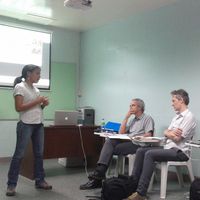The Missing Voice – Documentary Film in Southeast Asia | Part I
 „I have been to many international film-festivals in recent years and I have always been asking myself: Where are the Vietnamese contributions?“, says a young Vietnamese filmmaker at a recent regional documentary film meeting organised by the Goethe-Institut in Hanoi. I guess I returned to Vietnam to find an answer, to look for a solution.
„I have been to many international film-festivals in recent years and I have always been asking myself: Where are the Vietnamese contributions?“, says a young Vietnamese filmmaker at a recent regional documentary film meeting organised by the Goethe-Institut in Hanoi. I guess I returned to Vietnam to find an answer, to look for a solution.The two young women are not the only filmmakers who see it as their obligation to foster the independendent filmscene in Southeast Asia and who have put their full dedication into this mission. In recent years, more and more filmmakers have been teaming up, to raise the local Southeast Asian voice.
„There are many films that are made about Southeast Asia – but it is from international filmteams. The voice of the region is missing“, confirms a Thai filmmaker at the same workshop. „You do see films from China, India, Iran or Taiwan but where are the Southeast Asian contributions?“, asks another participant.
After gaining independence and freeing themselves from the colonial ties, the Southeast Asian region, like most the rest of Asia, has seen great economic growth and enormous social, political and cultural changes in the recent years. Given the heterogenity of the region, these changes vary from country to country. Yet phenomenas such as a continiously growing population, increase of wealth combined with a widening gap between rich and poor, accelerated growth of megacities or changing life-styles are only but a few of the recent developments that can be observed throughout the region.
These rapid changes have led to a greater urge to preserve the past and present, to document what is being gained and lost and to reflect on the transformations. Many young people are chosing documentary film as their medium to report about the world they see, to provide information about changing landscapes, about every day life and about people’s fates.
When looking at the general film industry in the region, there are a number of promising developments in the last years that have helped to attract international attention. A few countries, such as Singapore, Thailand and the Philippines have established a well-functioning film infrastructure helping to facilitate filmproduction for both local and foreign films. „In the past ten years, there has been a very powerful movement in independent cinema, especially in feature film in the Philippines“, highlights Filipino filmmaker Jag Garcia, who functions as the Deputy Chair of the National Committee of Cinema and Chair of the Digital Filmmaking Program at La Salle College Antipolo. „Also film labs now have much higher standards“, he continues. Even high-quality postproduction can be found within Southeast Asia now, a demand that before could only be met by neighbouring countries such as Australia, India or China.
Most Southeast Asian countries have also seen a couple of directors who have made it to the big international festivals, such as the French-based Cambodian filmmaker Rithy Panh, Nia Dinata from Indonesia or only recently the Thai Director Apfichatpong Werasethajul who won the Palme d’Or in Cannes for his film „Uncle Boornmee“. These directors certainly draw the attention of the international scene to the region. Quite promising is also the numbers of film festivals in Southeast Asia that have sprung to life mostly since the year of 2000. Some of them, like the Southeast Asian Film Festival in Singapore, also include documentary films in their programme.

But when taking a closer look, it becomes obvious that young filmmakers face a lot of issues: „Yes, there is a lot of development“, states Sakti Parentean, a young film activist from Indonesia. „The amounts of films produced – feature or documentary – is impressive. But often the quality is very low.“ As many countries within the region don't have filmschools, filmmakers often teach themselves or learn the essentials in improvised workshops. Also, existing filmschools often don't take documentary film seriously. It is is sometimes cut off in two seminars. The results are rarely convincing.
When looking at the financial side, filmmakers often receive their subsidies for low-budget film projects from international institutions or NGOs based in Southeast Asia. With very limited funding, these institutions provide budgets that can hardly match the needs for professional filmmaking, which is in international standards financed by big productions houses or well-budgeted TV channels. In this region production houses and TV channels rarely see documentary films of potential interest to their viewers. Thus they are not willing to invest money in local filmproductions. At the same time there are no other film funds. As a consequence, filmmakers see themselves in heavy debt and are not even sure their film will have any audience.
When looking at the international market, filmmakers from Southeast Asia still find it hard to get in. One of the reasons is that it is widely dominated by Western demand and interest. Thus many relevant topics from Southeast Asia, don’t seem to be of interest to the Western audience. This leads to phenomenas such as „Poverty Pornography“, which essentially means that filmmakers are producing films of which they know they will enter both the European and US market.
"The Western market wants to see films on poverty. If you are not talking about poverty, about war, about human-rights-violations, your film will most likely not make it to the international market", says Jag Garcia.
It is especially feature films from India, such as „The Apu Trilogy“ by Satyajit Ray, „Salaam Bombay“ by Mira Nair or „Slum Dog Millionare“ by Danny Boyle that have paved the way for this market. The smaller neigbours in Southeast Asia have chosen these films as their rolemodels for their own success, also in the field of documentaries.
The problems the filmscene in Southeast Asia is currently facing, boil down to education, funding, distribution and audience. These are no easy challenges to meet. Yet at the same time, the scene is promising and aspiring and the domestic market is huge. With the new financial possibilities of Southeast Asia, with many promising filmmakers waiting in the wings, with creative ideas on budgeting, with online-distribution as an emerging alternative and with many untold stories, hanging on to be shared, it seems to be a good timing for Southeast Asia to establish a strong filmindustry that will also focus on serious documentary films from this region. Only a united effort will give talented filmmakers from Southeast Asia the chance to share their unique view with the rest of the world.
Contributed by Katrin Sohns and Leyla Hoppe
Katrin Sohns is working at the Goethe-Institut Jakarta as the Regional Coordinator of the initiative „Culture and Development“. This initiative is committed to supporting cultural and media players with targeted educational and promotional programs. One of the main focus areas in the ASEAN region is Documentary Film Education. Prior to her current engagement she worked as the Editor a magazine on Politics, Economy and Culture in New Delhi / India and was engaged in the field of documentary film making in Germany for more than four years.
Leyla Hoppe is working at the Goethe-Institut for the initiative “Culture and Development” as part of a German culture exchange program. She is focusing on documentary film in Southeast Asia. During her time at the Goethe-Institut she has organized several workshops for filmmakers of Indonesia and the region, interviewed various filmmakers and is currently preparing a filmfestival in Indonesia.






